Birding inside Angkor Wat , Cambodia
Cambodia is a small country located in the Southeast Asian region tucked inbetween Thailand and Vietnam. It is particularly famous for its temples, especially Angkor Wat. Built in 12th Century by Suryavarman II, the Angkor Wat temple complex is a UNESCO World Heritage. The temple complex is spread across 162 hectares, which makes it one of the largest temple sites in the world. Angkor Wat is not only famous for its temple architecture but also for the sheer number of bird species. Birding inside Angkor Wat is always a very rewarding experience even for novice birders. The dense tall trees,water bodies around the temples make it a perfect spot for birds. There is also a close connection between South Indian Temple Architecture and Cambodia Khmer Architecture. The combination of architecture and birding made us decide to combine a bit of history and tropical birding.
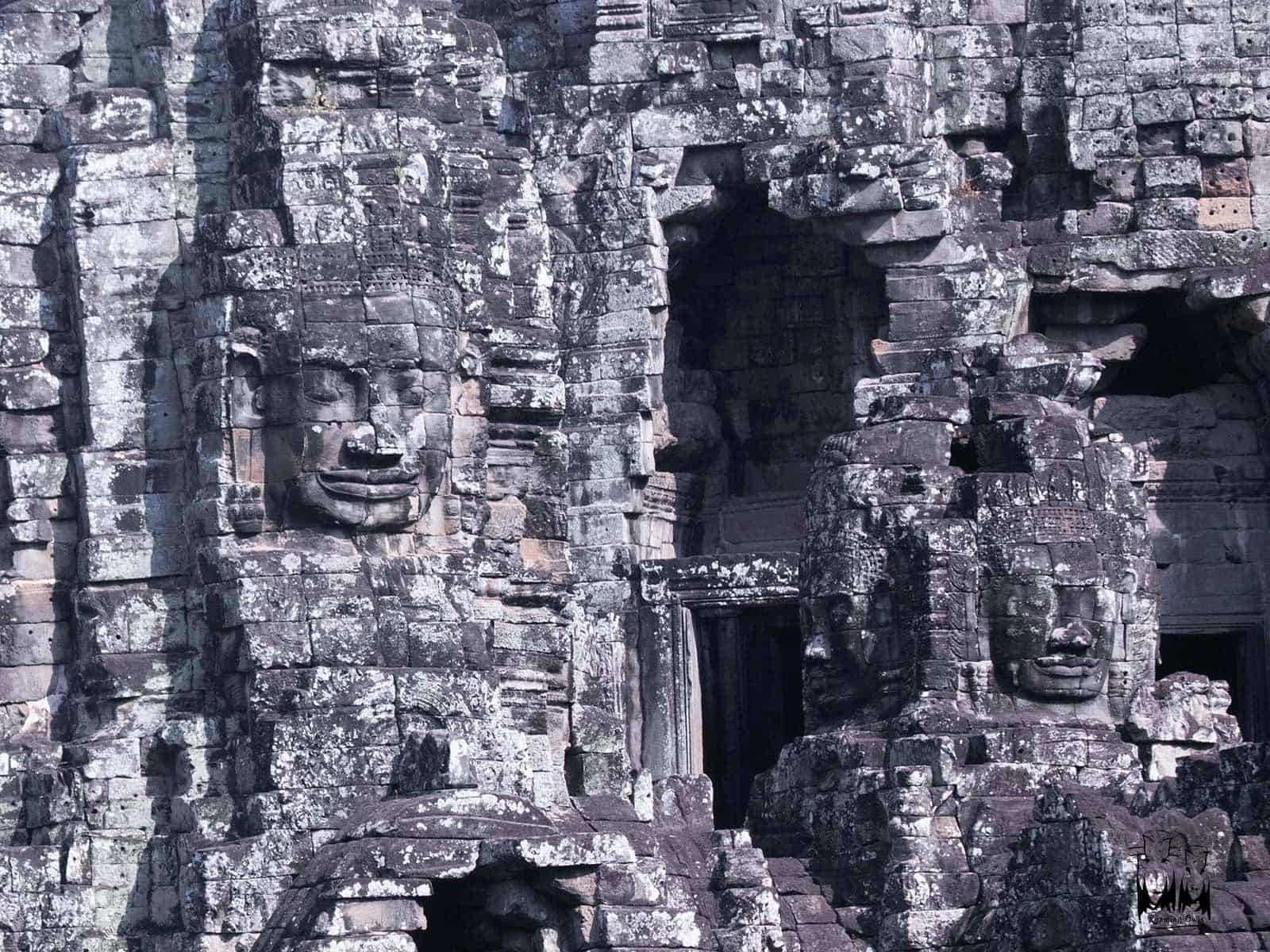
The smiling faces that greet you when you visit Angkor Wat. The hundreds of faces gives a very mystical feel once you reach the place.
Indians have On-Arrival Visa to Cambodia, so there was not any fuss on reaching Cambodia. Once we reached Siem Reap, Cambodia we went to the ticket complex where we bought the 3-day ticket for Angkor Wat. The roadsides were covered with Golden Shower tree which was in full bloom. We decided to go to the temple in evening to see sunset. But in the meantime, some friendly birds visited us near our room itself. The place where we stayed was densely covered with trees and so the place was filled with bird activities. It was a pleasant experience to see new bird species, especially in a new country. The first bird we saw in Cambodia was Blyth Flycatcher. That was followed by Yellow-vented bulbul, Olive-backed sunbird and Cambodia tailor bird. As we were running behind the birds, time flew away.
Birds in Cambodia
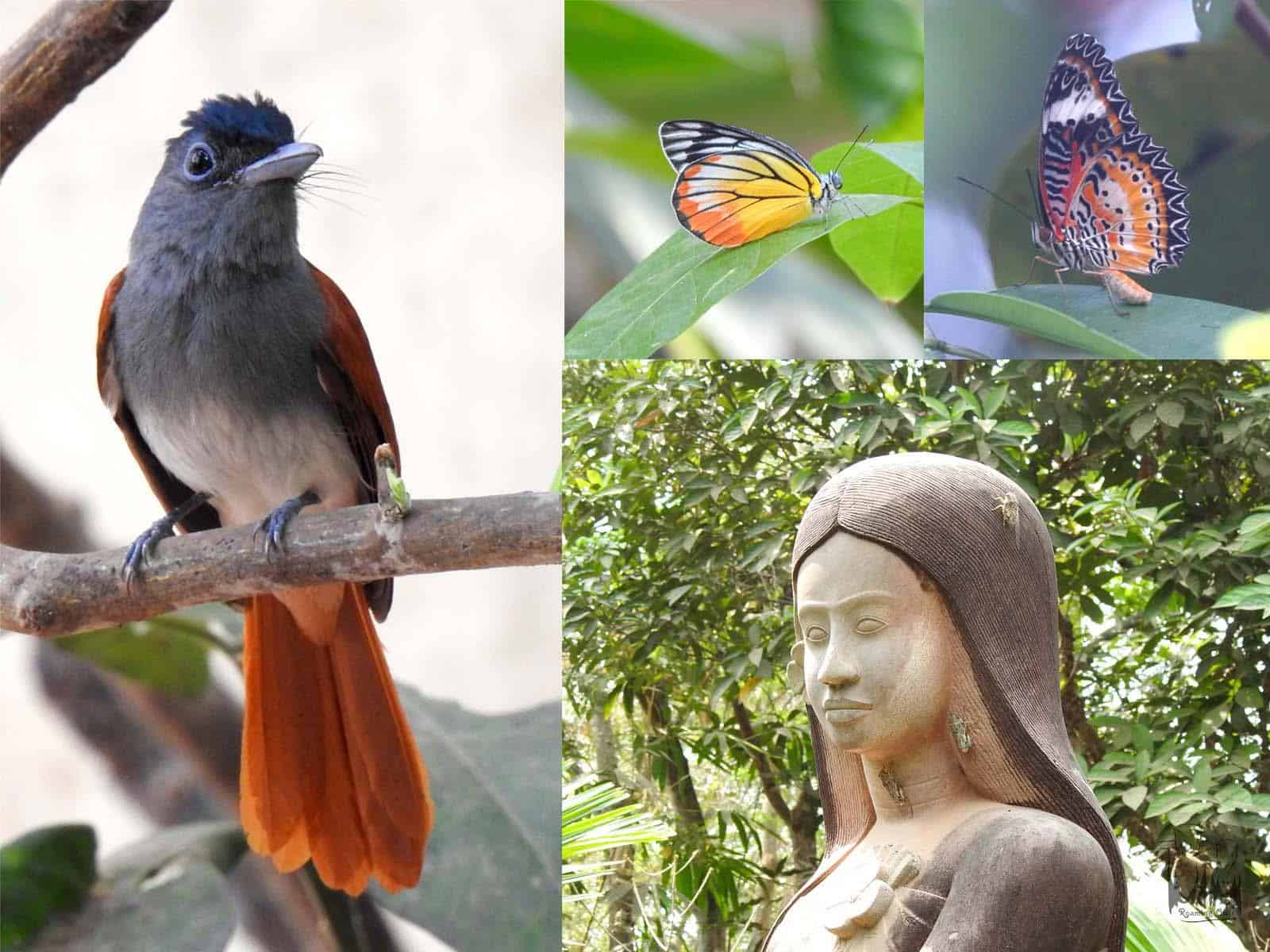
We started our birding from the place we stayed. Our first bird, Blyth flycatcher looked similar to the Asian paradise flycatcher found in India. As usual we went after the butterflies too, finding the Painted jezebel and Leopard lacewing butterflies along with several others. Apart from the birds and butterflies the most immersive jungle experience was provided by the cicadas and they seemed to be everywhere, even a statue in the resort was not spared.
Now it was time for birding inside Angkor Wat. I was told that Phnom Bakheng temple was the Sunset Place in Angkor Wat Temple Complex, so we started to Phnom Bakheng. We went to the temple in tuktuk which was the local transport to roam around. But when we entered the Angkor Wat Temple Complex, we were stunned seeing the Angkor Wat Temple and got down there itself instead of going to Phnom Bakheng. I have seen so many photos and videos of this temple but when I stood infront of Angkor Wat , I got a reality check on its magnificence. While we were walking towards the temple, I saw some raptors circling above. When I watched it in binoculars, found it was Black Baza. We were torn between the idea of going inside the temple or roaming around the trees surrounding the temple. We were hearing different birds sounds and continuous humming of cicadas. Just to end our dilemma, White-throated Rock Thrush came and sat infront of us.
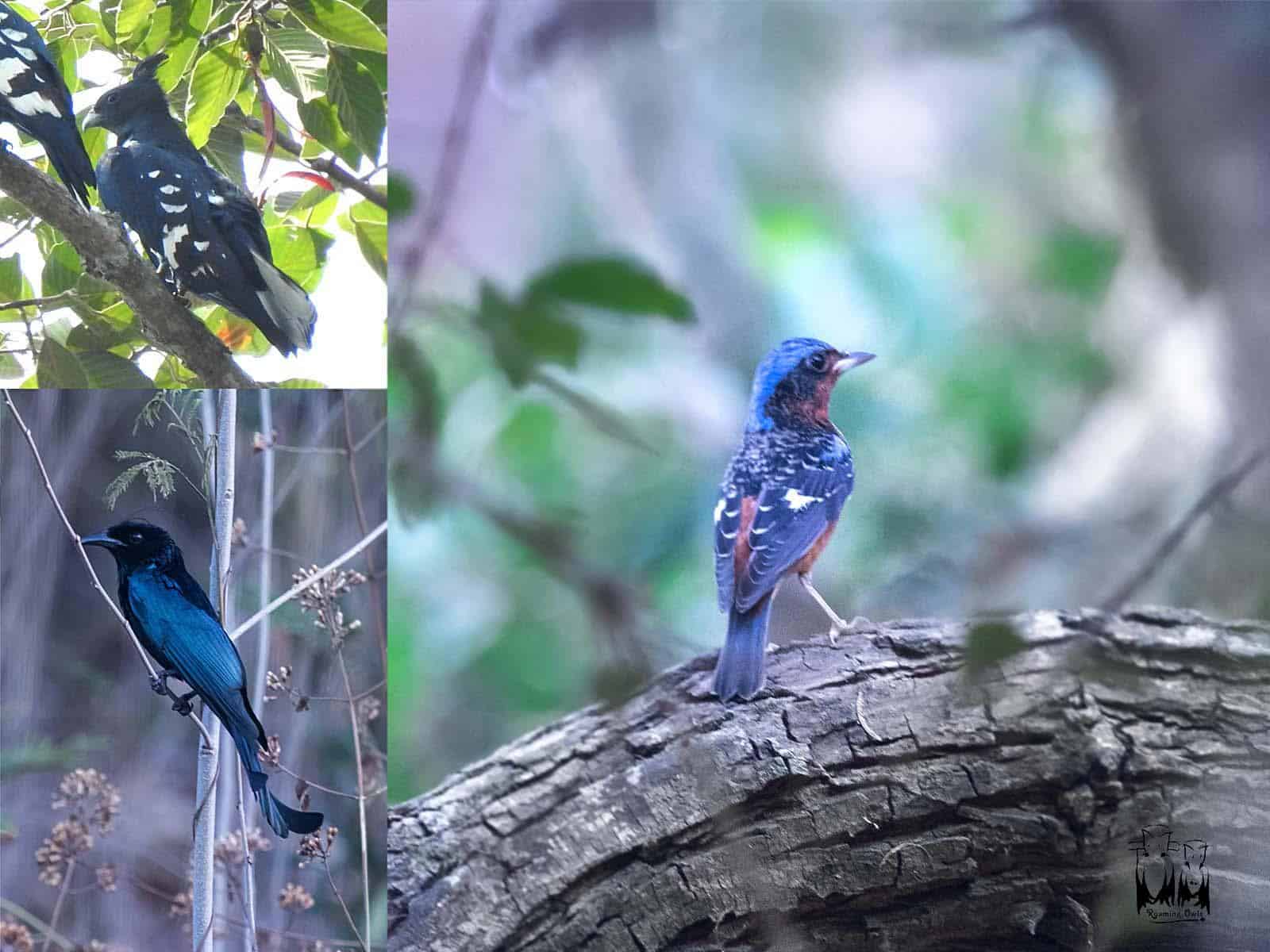
The White-throated rock thrush was a beautiful bird to look at and so was the Spangled drongo with it’s iridescent wings. Black baza was obviously the highlight but we could only get a flight shot. The above image was from the next day spotting !
So we decided to continue with our birding and visit the temple the next day. Racket-tailed Drongo, Copper Smith Barbet, Barred Owlet, Ashy Minivet were flying around and we also saw Blue rock thrush on the temple wall. Once the bird activities slowed down, we decided to continue our plan to visit Phnom Bakheng for Sunset.
Phnom Bakheng was in a small hillock, so we quickly started climbing uphill. Once we reached the top, to our dismay there was a long queue. There were tourists standing on the ruins to watch the sunset. It was no fun to watch sunset standing in a queue. So we started walking down and stopped at a opening to see the sunset. The sunset was quite ordinary for all its build up expectation. We had seen better sunsets in Kanyakumari itself.
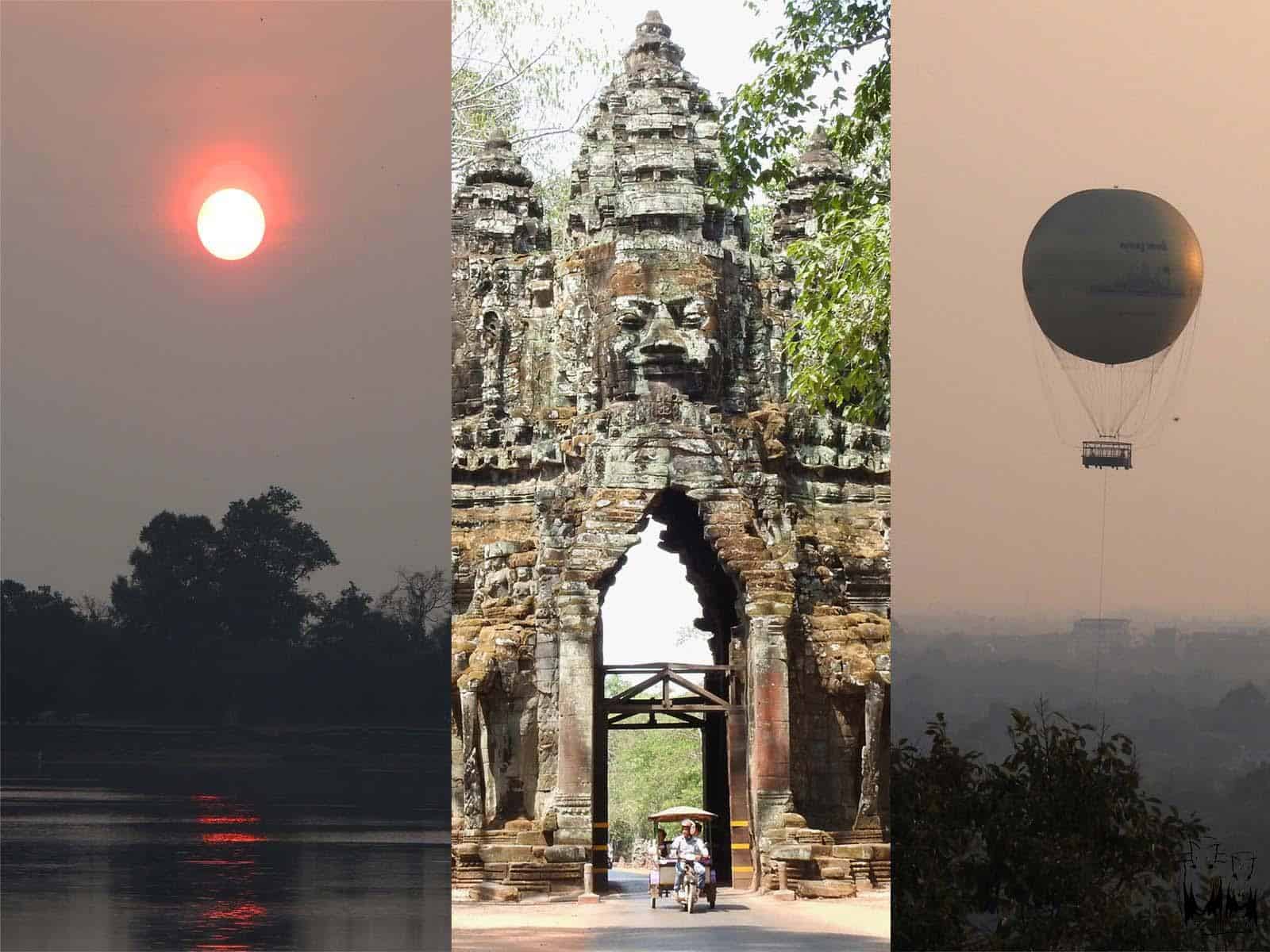
Travelling in a Tuktuk was like travelling on a unstable platform. Tuktuk was basically a rickshaw with a motorbike attached to it’s front. We could say that this travel was much more exciting than the sunset!
Usually the tourists come to Angkor Wat only to see the temples, but we wanted to do birding in Angkor Wat and also see the temples. So we rented two-wheeler and made an early start to the temple. Two wheeler gave us immense freedom to roam around the huge temple complex and stop at all nook and corners, after all , that was part of the birding in Angkor Wat experience. The temples were opened only at 7.30 AM but the entry to the main temple complex was allowed from 5.30 AM to watch Sunrise.
We went to the water reservoirs near the temples to see birds. We went in March which was the driest season of the year. Still the water level in reservoirs were good, but except for cormorants there was no bird in sight. Khmer Kingdom was famous not only for the temples but also for the dams they built. These reservoirs were called Baray and they were grander than the Khmer temples. We went to Jayatataka temple crossing the Northern Baray. East Baray was fully dried out and now converted to paddy fields.

Birding inside Angkor Wat would not be complete without visiting the water bodies there. The large water body surrounding the temple was man-made. We hoped to see many birds in the water body but it turned out to be a disappointment.
There were tall trees surrounding the Jayatataka temple, so we sat down to eat our breakfast which was given from the place we stayed. Suddenly there were some birds activities nearby, it looked like the birds knew we sat for breakfast. So we put down our half eaten pancakes and took the camera and ran behind the birds. The birds were running behind the bushes. Finally we spotted the Green-billed malkoha which came out from the hiding. Green-billed malkoha can be found in India itself, but its quite a shy bird and quite hard to spot. But in this trip we saw quite a number of Green-billed malkohas. After taking photograph of Green-billed malkoha we were back to continue our breakfast.
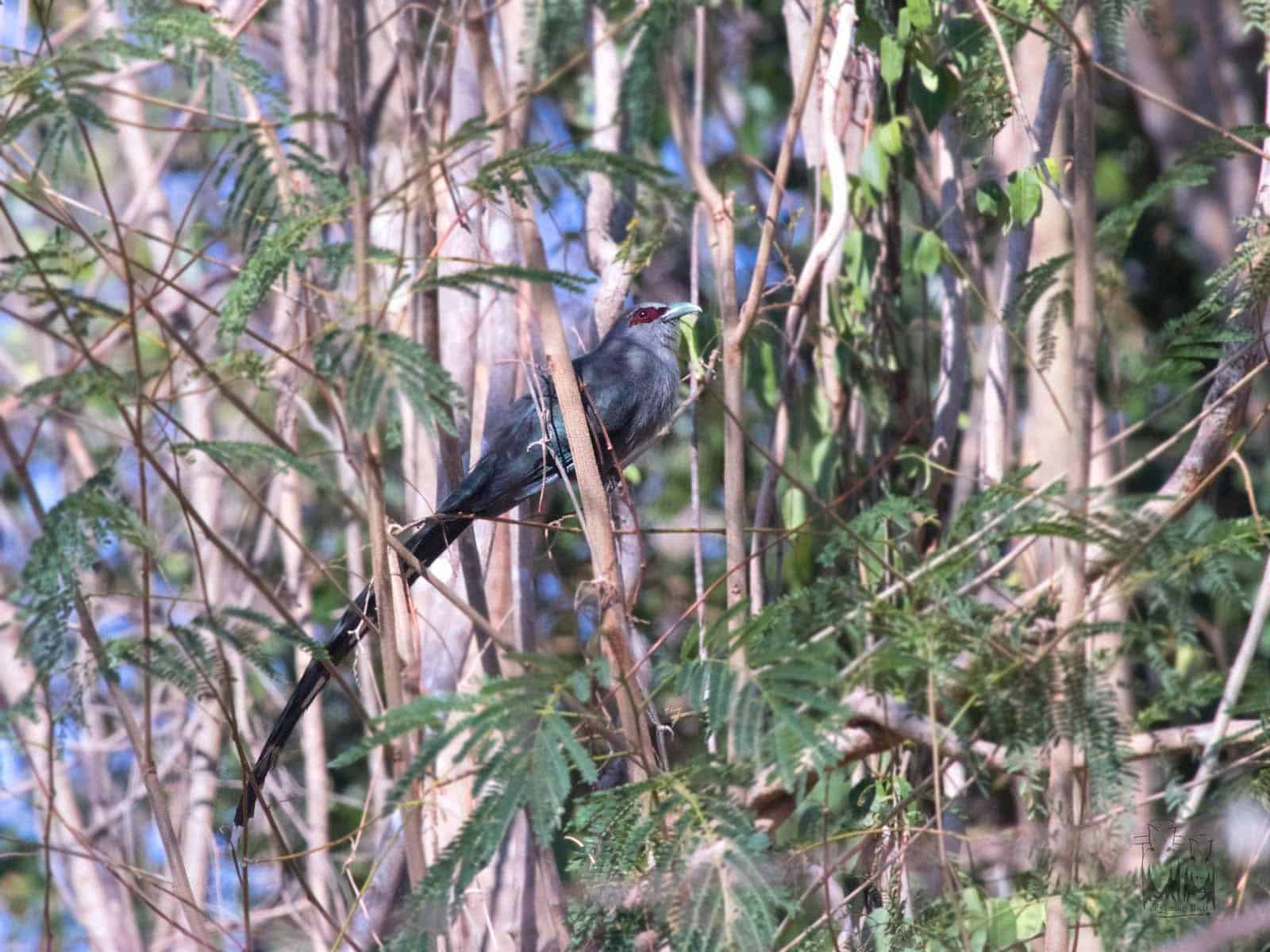
A shy and often hard to find bird in India, the Green-billed malkoha seemed to be around every corner. That did not mean it poses for a picture , we still had to sweat it out to get a shot in between the twigs.
By this time the temples,shops were open and tourists started pouring in. The sales ladies had quite a slang and were persuading the tourists to buy something from them. Our next stop was to Preah Khan temple. The enroute from Jayatataka to Preah Khan was beautiful with tall trees on the roadsides. We were lucky to spot a pair of Black Bazas sitting on the top of a tree. After spotting few more flycatchers we reached Preah Khan temple. Even though we didn’t stand directly under the sun, we were drenched in sweat by the time we reached Preah Khan temple. The sight of tender coconut in the shop opposite to the temple was so welcoming. The big tender coconut was easily cut by the girl in the shop and we quenched our thirst drinking the sweet,cold tender coconut water. We are from Nagercoil,Tamilnadu known for its coconut farms, but we have never seen tender coconuts this big.

Our favorite among the temples was Preah Khan. The abundant greenery and relatively lesser number of tourists made it an ideal place for birding inside Angkor Wat.
Preah Khan temple looked very beautiful or maybe our eye sights were better after drinking tender coconut water. The entrance to the temple depicted the churning of the ocean of milk but most were headless. We stopped at the first tree itself as we spotted a nicely patterned gecko. The Silk cotton trees here were so tall and the branches were intertwined with the temple towers. One hall in this temple displays pictures of dancing Apsaras, so the hall was named as Hall of Dancers. The Preah Khan is a big temple with multiple entrances and we walked through the temple seeing an old lady selling lucky bracelets,dancing apsaras and the trees. We lost our energy again in that humidity, so we got sliced pineapples to revitalize and moved to the famous Bayon temple.

Tropics might be hot and humid but nature compensates by it’s juicy creations. This might be the heat speaking but the Pineapples and tender coconuts we tasted seemed like the best in the world.
The Bayon temple was quite different from the other temples we had visited so far. There were more than 200 huge statues of smiling faces in the temple. There was a speculation whether its the face of Lord Logeswara or King Jeyavarman VII. As long as it was not the statue of a film actor we didn’t have any issue. In the tall trees that surrounded the temple, Red-breasted parakeets were flying around in flocks and plucking the fruits from the trees. Their racketing sound was louder than the tourists in the temple. We enjoyed the parakeets talkative show and then we went to few other temples nearby.
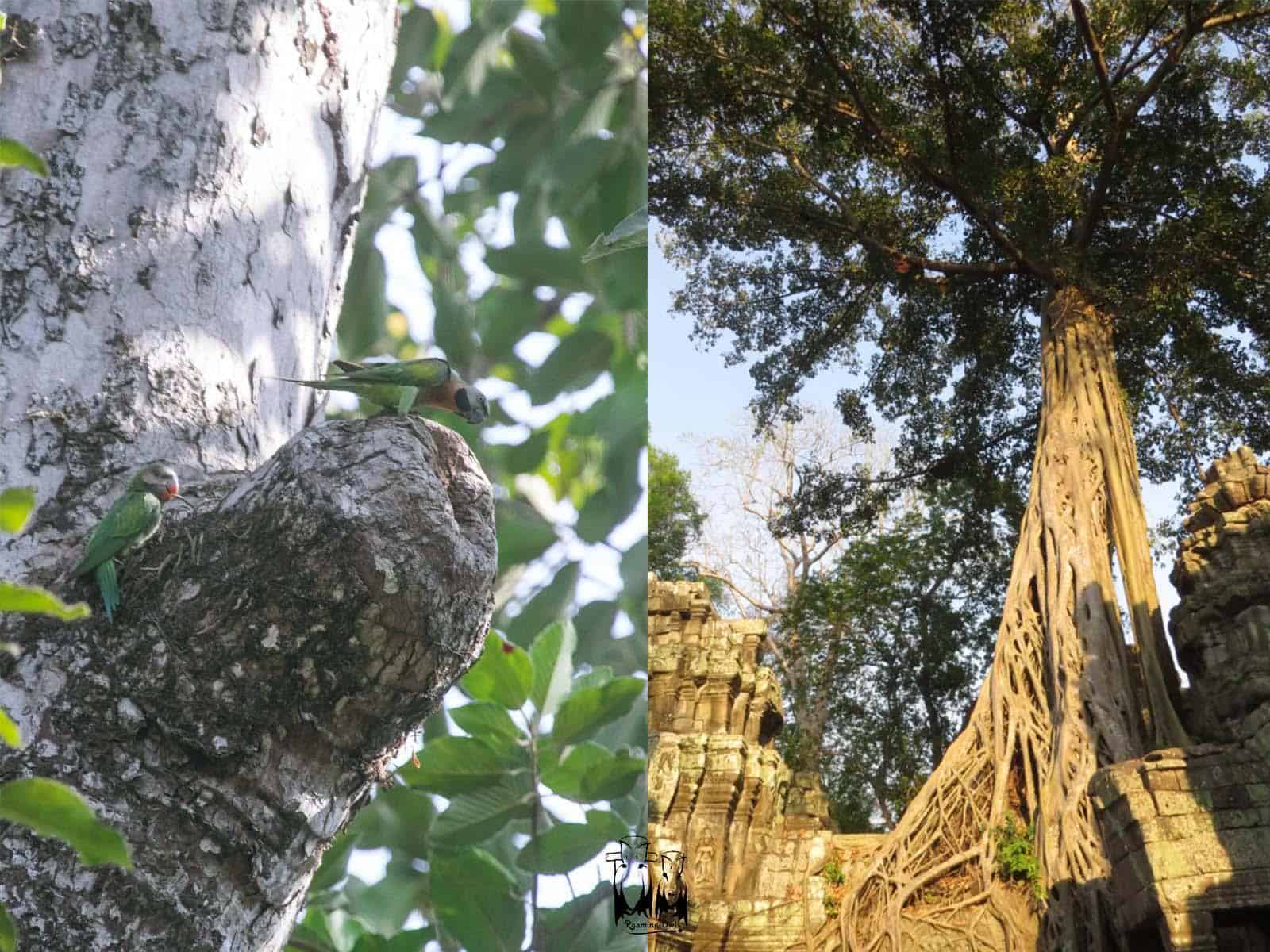
Parakeets are chatter boxes and when they start, they hardly seem to stop. The Red-breasted parakeets were so many on top of the tall trees that they engulfed the area with their chatting.
Our final stop for the day was to the most famous Ta Prohm temple. Tetrameles nudiflora and Silk Cotton trees were so huge and their branches,roots were covering the temple towers. We have silk cotton trees in India, but I have never seen such a tall tree. The Ta Prohm temple had become famous because of the Tomb Raider movie, so there were lots of tourists posing around the tall trees. As far as me is concerned, the tall trees in Preah Khan temple also looked similar and I would prefer the less crowded Preah Khan to Ta Prohm temple.
Usually when you visit old temples one can see bats in the old temples, so we were searching them in all temples. Finally we saw hanging bats in one of the towers in Ta Prohm. We were happy to have found it as we consider all bats as a special find. Outside the temple, the roots of the strangler fig,silk cotton,thitpok trees looked like the tentacles of a large reptile crushing the temple. The Silk cotton trees looked like they were literally going to touch the sky. There were birds hopping around those tall trees, but we couldn’t even identify them as they were so high on the trees. Ta Prohm temple looked good, but we were more impressed with those gigantic trees than with the temple.
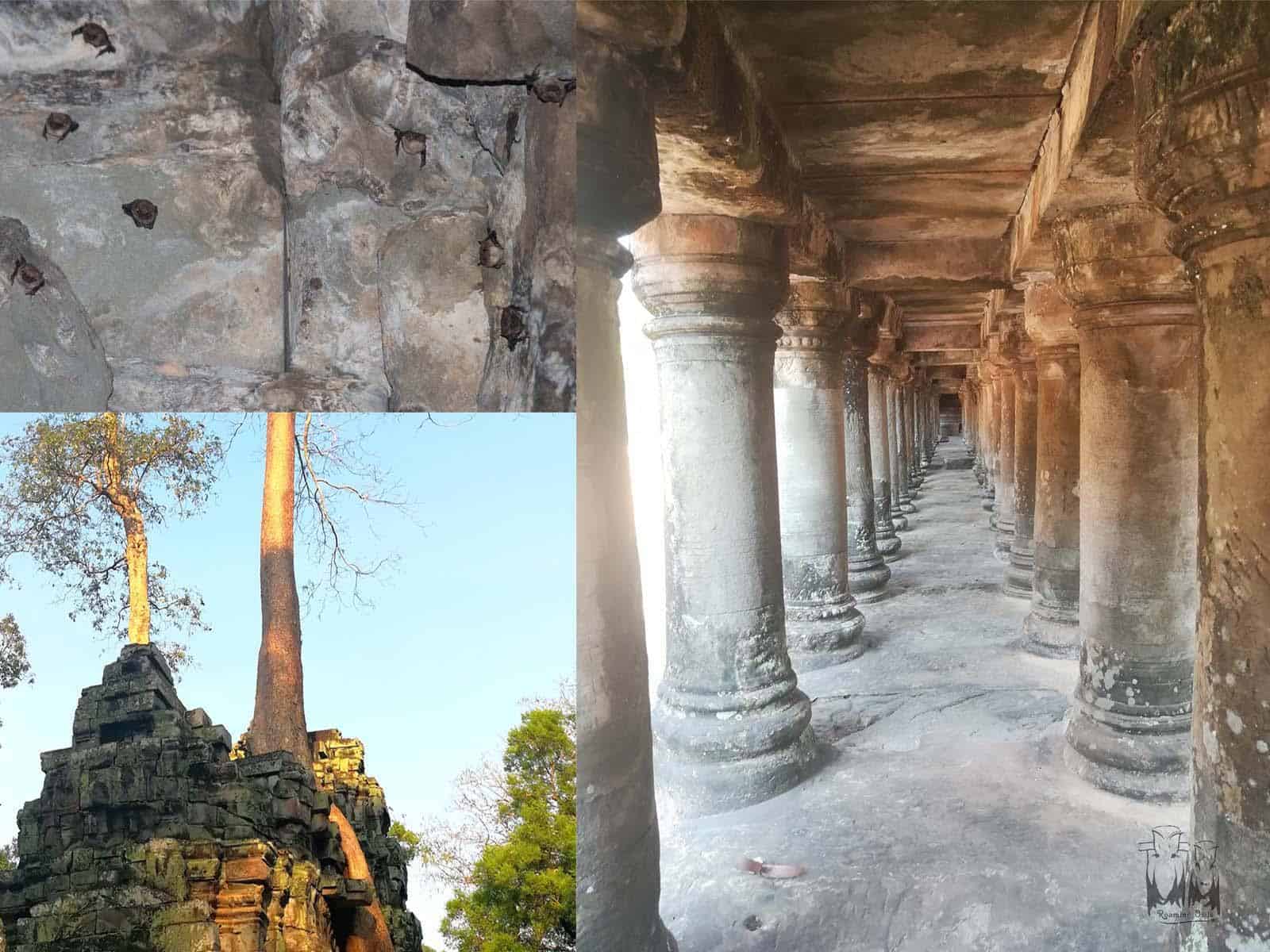
Searching and finding bats is always a nice activity to do for us. They add an element of mystery to the ecology. Even though they are a vital link in the ecosystem hardly anyone covers them. The temples seemed to be a perfect cave for them.
By this time we were exhausted after running behind the birds and marvelling about the different temples. So we called it a day and returned back to our resort. We didn’t have a meal the whole day as we were just drinking tender coconuts to quench our thirst. So we ate Cambodian dishes for dinner till our stomach couldn’t take anymore. No, we didn’t try any of their insect fries.
On our final day to Angkor Wat temple complex, we visited the main Angkor Wat temple at Sunrise. The crowds were standing infront of the moat to see the sunrise, so we walked around the walls of the temple. There was nobody other than us. We saw Zebra dove, Black-naped oriole, Lineated barbet, Forest Wagtail, Asian barred owlet and many other birds. Finlaysonii squirrels were jumping around and eating the nuts from the trees. When we were watching a tree to spot a bird which was making quite a high pitch sound, we saw Oriental pied hornbill flew and sat on a tree near the moat. By the time we reached there, few more hornbills joined the first one and they were very playful.
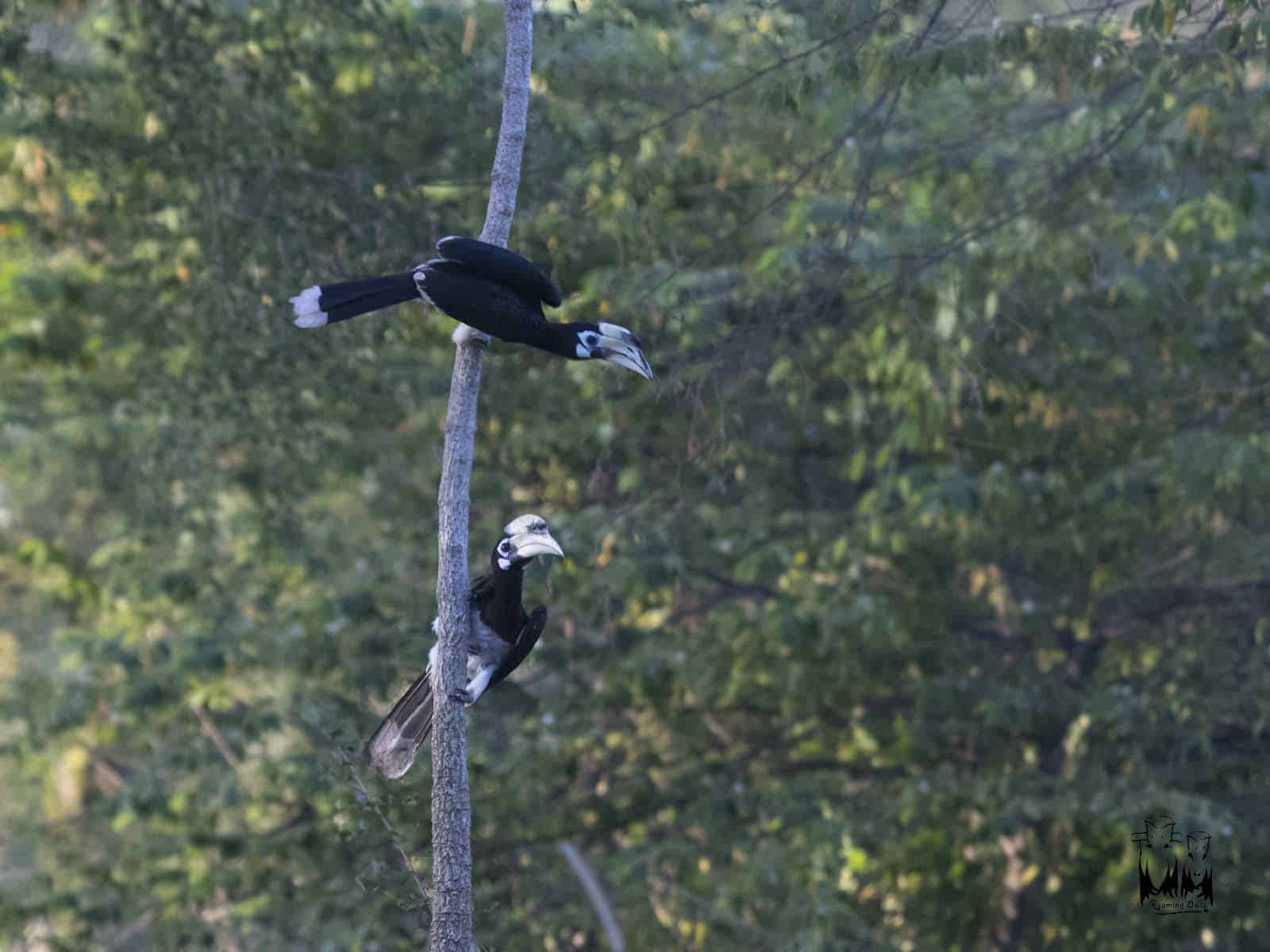
Oriental pied hornbill in a group seemed to be more playful than a group of babblers. These large birds were hoping from one branch to another playfully and were putting on quite a show.
We watched them playing with one another and then went to the temple. The temple was crowded then, so we had a quick tour in the temple and came out. This was the only temple where we saw monks doing rituals and devotees giving offering. When we visited this temple first day, we saw Blue rock thrush bird on the walls and we saw him again.We had a memorable experience doing birding inside Angkor Wat but the heat was unbearable.
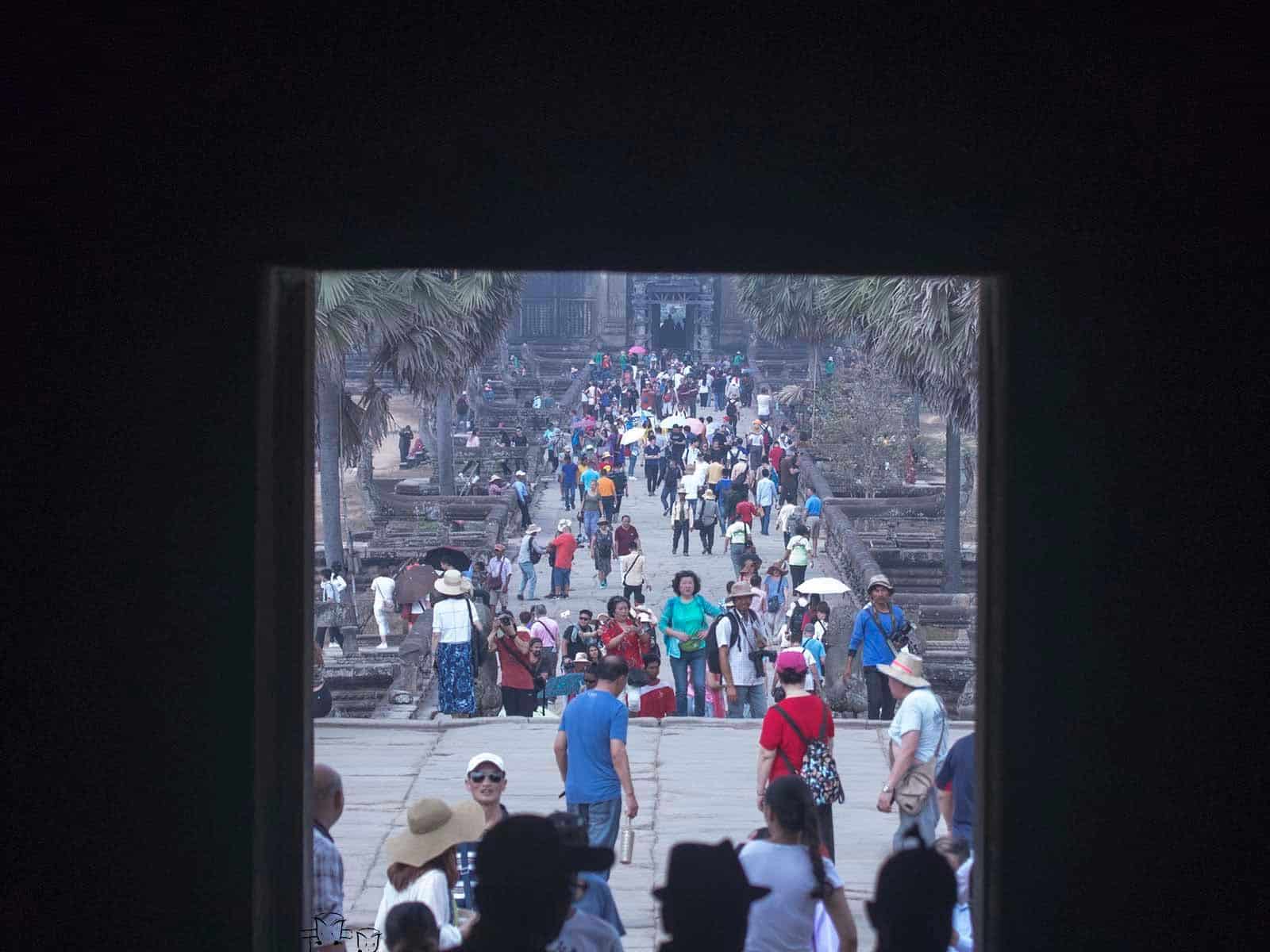
The crowd in the main temple was massive. It looked like Chinese have taken over the world from the westerners. We could literally see the impact of Chinese everywhere from the shops to the airport.
When we visited Srilanka, because of rain we couldn’t visit any places. So we planned to Cambodia in Summer. Coming from India we thought we could brave the Sun,but we couldn’t. Another least expected but a pleasant surprise was Cicadas. The Cicada sound was literally everywhere we went. It made the forests around the Angkor Wat Complex more lively. The temples surely will look more beautiful in the rains, so we decided to come back during rainy season and bid our farewell to Angkor Wat. Keep this in your wishlist if you are a architecture lover or bird lover!
For the Tamil Version of the blog click here
I have also uploaded a short video of our trip